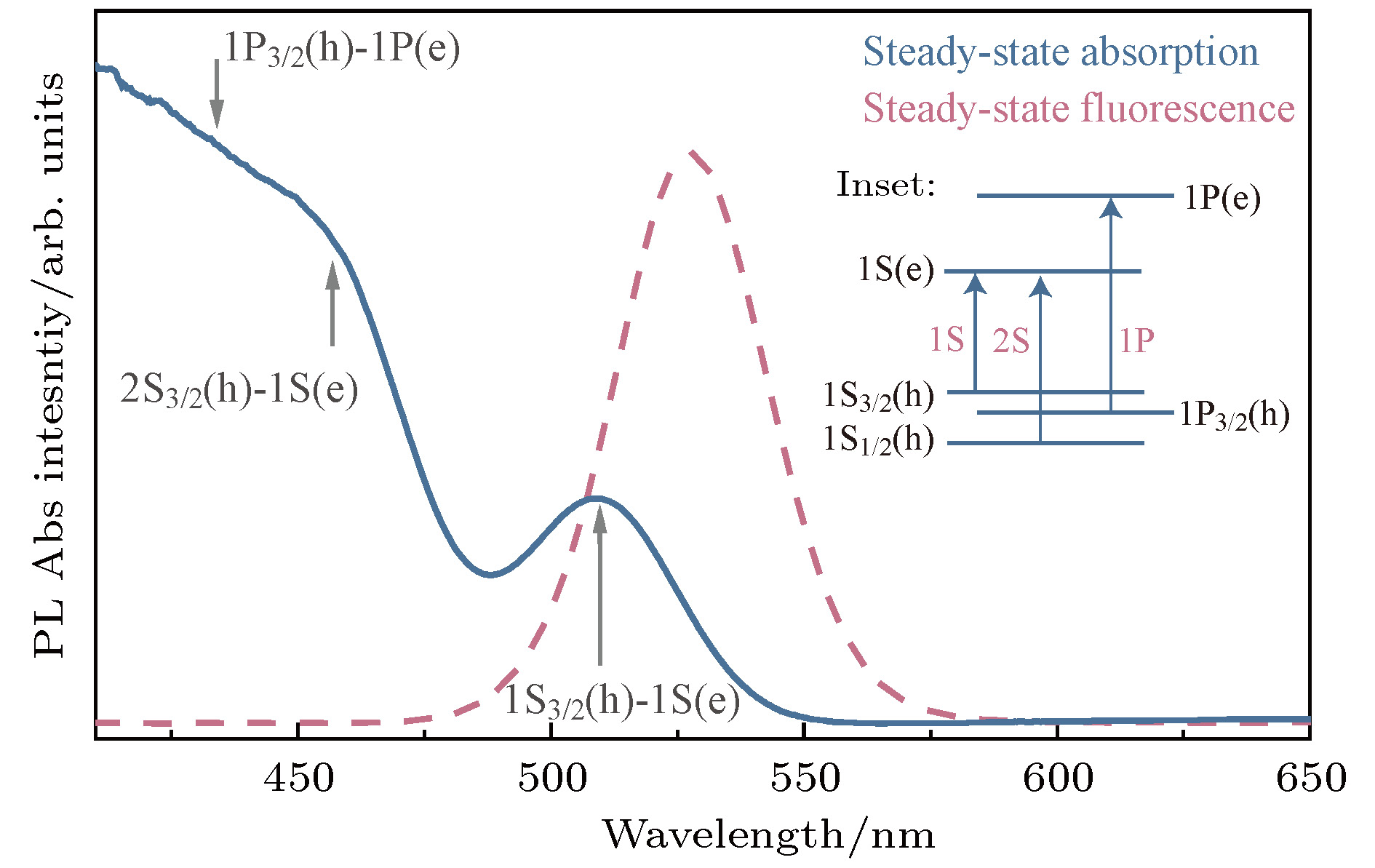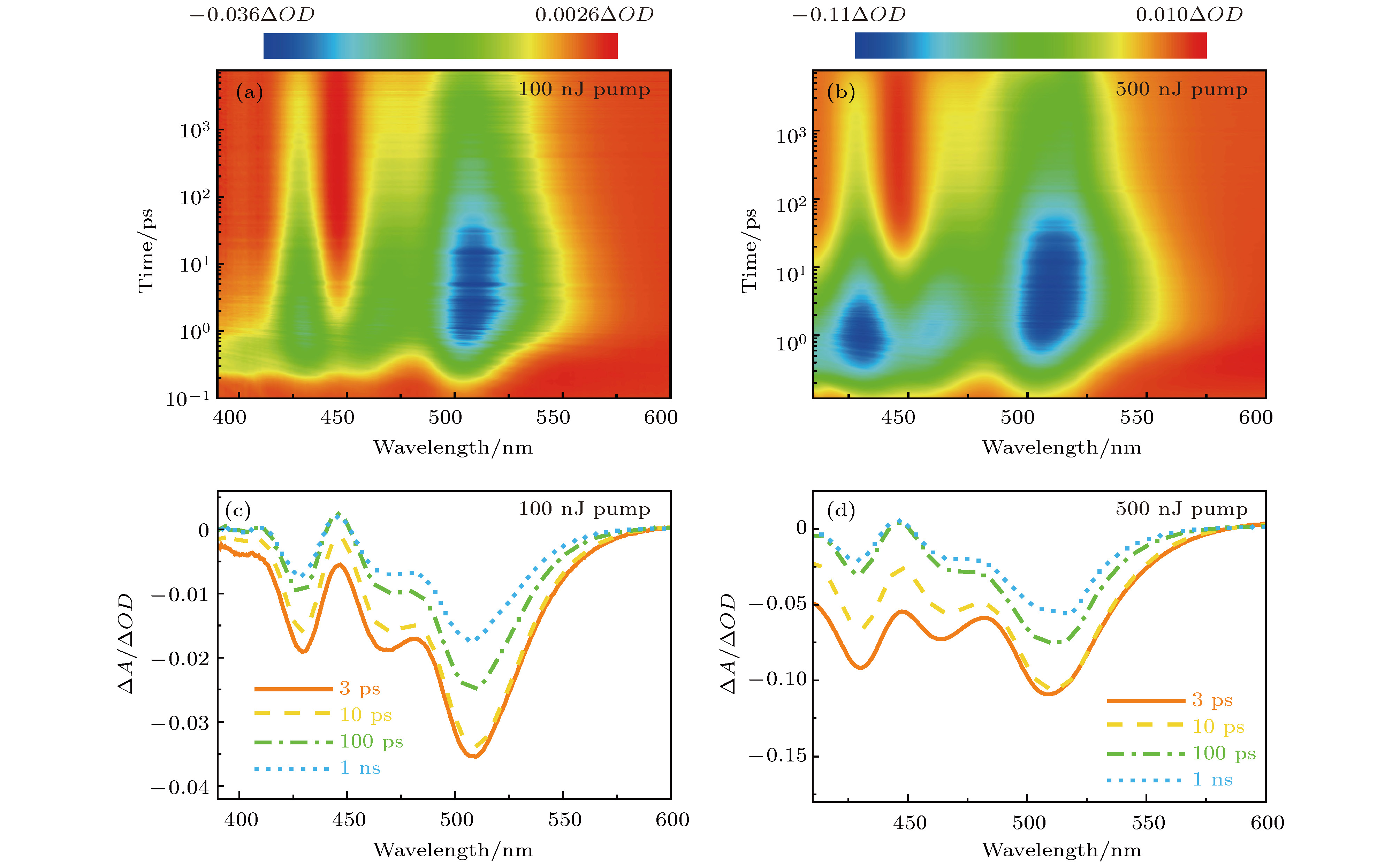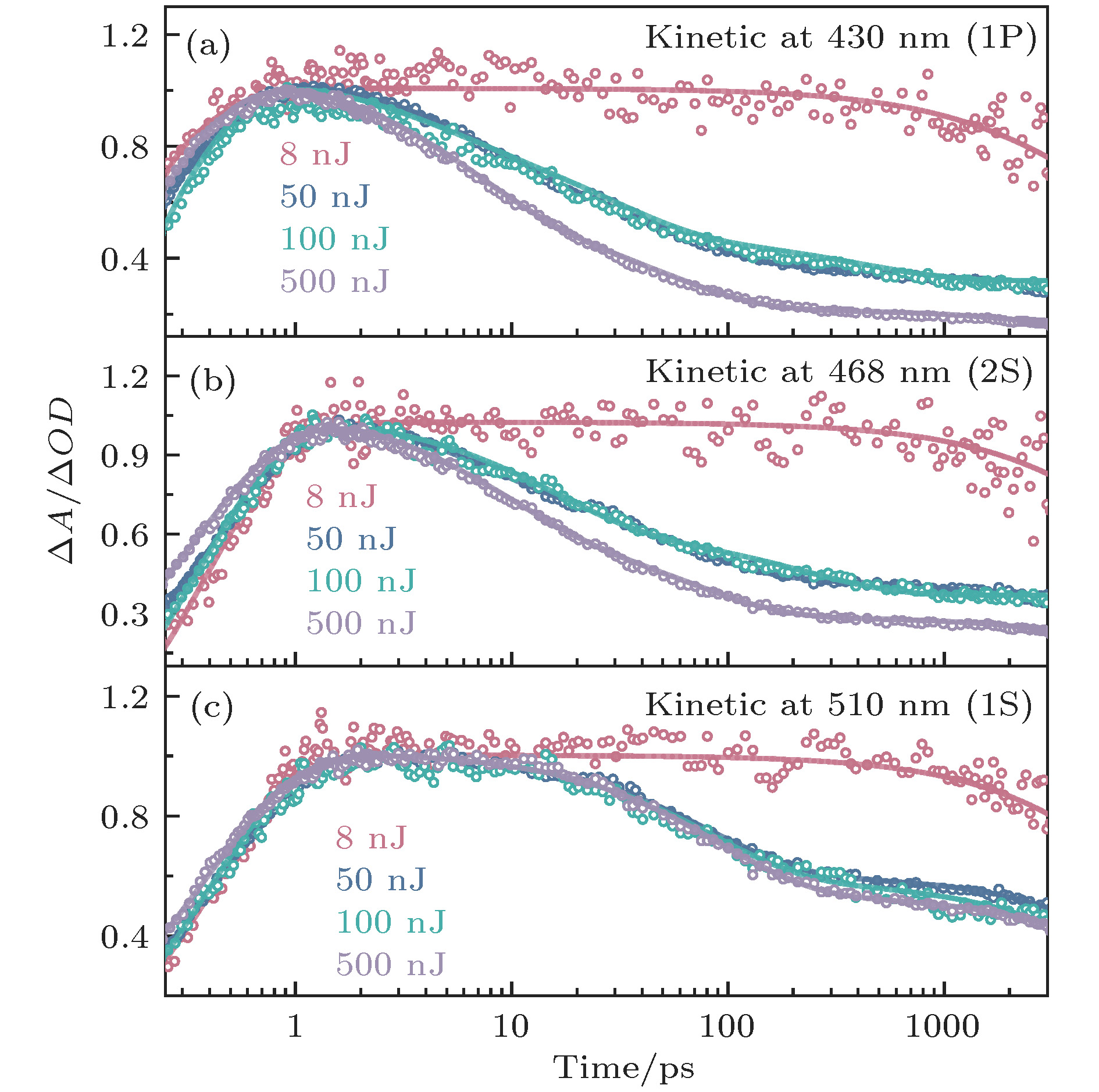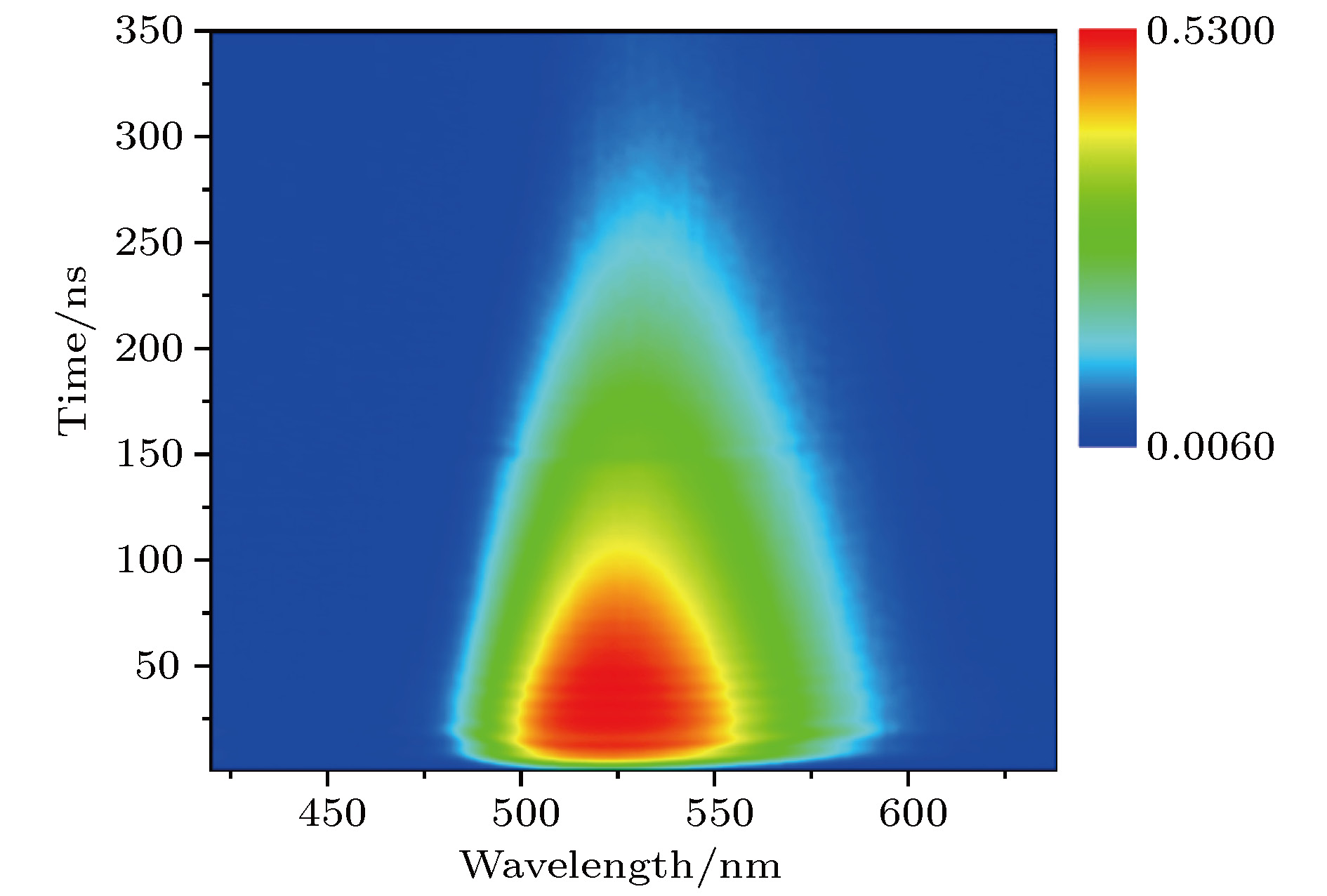-
多激子效应通常是指吸收单个光子产生多个激子的过程, 该效应不仅可以为研究基于量子点的太阳能电池开拓新思路, 还可以为提高太阳能电池的光电转换效率提供新方法. 但是, 超快多激子产生和复合机制尚不明确. 这里以CdSeS合金结构量子点为研究对象, 研究了其多激子生成和复合动力学. 稳态吸收光谱显示, 510, 468和430 nm附近的稳态吸收峰, 分别对应1S3/2(h)-1S(e) (或1S), 2S3/2(h)-1S(e) (或2S)和1P3/2(h)-1P(e) (或1P)激子的吸收带. 通过飞秒时间分辨瞬态吸收光谱和纳秒时间分辨荧光光谱两种时间分辨光谱技术对CdSeS合金结构量子点的超快动力学进行了探究, 结果显示, 1S激子的双激子复合时间大概是80 ps, 这一时间比传统量子点的双激子复合时间(小于50 ps)延长了近一倍, 结合最近发展的超快界面电荷分离技术, 在激子湮灭之前将其利用起来, 这一时间的延长将有很大的应用前景; 其中, 在2S和1P激子中除上述双激子复合外, 还存在一个通过声子耦合路径的空穴弛豫过程, 时间大概是5—6 ps. 最后, 利用纳秒时间分辨荧光光谱得到该样品体系单激子复合的时间约为200 ns.Multiexciton generation is a process where multiple excitons are generated by absorbing single photons. Efficient multiexciton generation in quantum dots may be a revolutionary discovery, because it provides a new method to improve the solar-to-electric power conversion efficiency in quantum dots-based solar cells and to design novel quantum dots-based multielectron or hole photocatalysts. However, the mechanism of ultrafast multiexciton generation and recombination remain unclear. In this paper, alloy-structured quantum dots, CdSeS, are prepared by the hot injection method. The generation and recombination mechanism of charge carriers in quantum dots samples are discussed in detail. The bivalent band structure of alloy-structured quantum dots is determined by ultraviolet-visible absorption spectra. It is found that the 1S3/2(h)-1S(e) (or 1S), 2S3/2(h)-1S(e) (or 2S) and 1P3/2(h)-1P(e) (or 1P) exciton absorption bands of these quantum dots are at 510 nm, 468 nm and 430 nm, respectively. Femtosecond transient absorption spectroscopy and nanosecond time-resolved photoluminescence spectroscopy are used to investigate the ultrafast exciton generation and recombination dynamics in the alloy-structured quantum dots. By fitting the transient kinetics of 1S exciton bleach, an average biexciton decay time is obtained to be about 80 ps, which is almost twice the decay time of traditional quantum dots (less than 50 ps). Combined with the recently developed ultrafast interface charge separation technology that can extract multiple excitons before their annihilation, it will have a promising application prospect. Moreover, there is a hole relaxation on a the time scale of 5-6 ps via a phonon coupling pathway to lower-energy hole states in addition to the above-described ultrafast exciton-exciton annihilation process in 2S and 1P excitons. Furthermore, by nanosecond time-resolved photoluminescence spectroscopy, it can be concluded that the charge separated state is long-lived (200 ns). Our findings provide a valuable insight into the understanding of ultrafast multiexciton generation and recombination in quantum dots. These results are helpful to understand the intrinsic photo-physics of multiexciton generation in quantum dots, to implement the photovoltaic and optoelectronic applications, and to ascertain the exciton relaxation dynamics of quantum dots.
[1] Shockley W, Queisser H J 1961 J. Appl. Phys. 32 510
 Google Scholar
Google Scholar
[2] Werner J H, Kolodinski S, Queisser H J 1994 Phys. Rev. Lett. 72 3851
 Google Scholar
Google Scholar
[3] Beard M C, Luther J M, Nozik A J 2014 Nat. Nanotechnol. 9 951
 Google Scholar
Google Scholar
[4] ten Cate S, Sandeep C S S, Liu Y, Law M, Kinge S, Houtepen A J, Schins J M, Siebbeles L D A 2015 Acc. Chem. Res. 48 174
 Google Scholar
Google Scholar
[5] Tahara H, Sakamoto M, Teranishi T, Kanemitsu Y 2017 Phys. Rev. Lett. 119 247401
 Google Scholar
Google Scholar
[6] Tahara H, Sakamoto M, Teranishi T, Kanemitsu Y 2018 Nat. Commun. 9 3179
 Google Scholar
Google Scholar
[7] Damtie F A, Karki K J, Pullerits T, Wacker A 2016 J. Chem. Phys. 145 064703
 Google Scholar
Google Scholar
[8] Park Y S, Guo S J, Makarov N S, Klimov V I 2015 ACS Nano 9 10386
 Google Scholar
Google Scholar
[9] Hu F R, Yin C Y, Zhang H C, Sun C, Yu W W, Zhang C F, Wang X Y, Zhang Y, Xiao M 2016 Nano Lett. 16 6425
 Google Scholar
Google Scholar
[10] Hu F R, Zhang H C, Sun C, Yin C Y, Lü B H, Zhang C F, Yu W W, Wang X Y, Zhang Y, Xiao M 2015 ACS Nano 9 12410
 Google Scholar
Google Scholar
[11] Zhao G, Cai Q B, Liu X T, Li P W, Zhang Y Q, Shao G S, Liang C 2019 IEEE J. Photovolt. 9 194
 Google Scholar
Google Scholar
[12] Chen Z H, Zhang Z L, Yang J F, Chen W J, Teh Z L, Wang D, Yuan L, Zhang J B, Stride J A, Conibeer G J, Patterson R J, Huang S J 2018 J. Mater. Chem. C 6 9861
 Google Scholar
Google Scholar
[13] Lin Q L, Yun H J, Liu W Y, Song H J, Makarov N S, Isaienko O, Nakotte T, Chen G, Luo H M, Klimov V I, Pietryga J M 2017 J. Am. Chem. Soc. 139 6644
 Google Scholar
Google Scholar
[14] Zhang Z L, Chen Z H, Yuan L, Chen W J, Yang J F, Wang B, Wen X M, Zhang J B, Hu L, Stride J A, Conibeer G J, Patterson R J, Huang S J 2017 Adv. Mater. 29 1703214
 Google Scholar
Google Scholar
[15] Li Q Y, Xu Z H, McBride J R, Lian T Q 2017 ACS Nano 11 2545
 Google Scholar
Google Scholar
[16] Debnath T, Maity P, Maiti S, Ghosh H N 2014 J. Phys. Chem. Lett. 5 2836
 Google Scholar
Google Scholar
[17] Spencer A P, Peters W K, Neale N R, Jonas D M 2019 J. Phys. Chem. C 123 848
 Google Scholar
Google Scholar
[18] Al-Ghamdi M S, Sayari A, Sfaxi L 2016 J. Alloys Compd. 685 202
 Google Scholar
Google Scholar
[19] Kwak G Y, Kim T G, Hong S, Kim A, Ha M H, Kim K J 2018 Sol. Energy 164 89
 Google Scholar
Google Scholar
[20] Zhang P F, Feng Y, Wen X M, Cao W K, Anthony R, Kortshagen U, Conibeer G, Huang S J 2016 Sol. Energ. Mat. Sol. C 145 391
 Google Scholar
Google Scholar
[21] Kryjevski A, Mihaylov D, Kilina S, Kilin D 2017 J. Chem. Phys. 147 154106
 Google Scholar
Google Scholar
[22] Amori A R, Hou Z T, Krauss T D 2018 Annu. Rev. Phys. Chem. 69 81
 Google Scholar
Google Scholar
[23] Schaller R D, Sykora M, Pietryga J M, Klimov V I 2006 Nano Lett. 6 424
 Google Scholar
Google Scholar
[24] Ghimire S, Biju V 2018 J. Photoch. Photobio. C 34 137
 Google Scholar
Google Scholar
[25] Zhu H, Lian T 2012 J. Am. Chem. Soc. 134 11289
 Google Scholar
Google Scholar
[26] Shi X F, Xia X Y, Cui G W, Deng N, Zhao Y Q, Zhuo L H, Tang B 2015 Appl. Catal. B. Environ. 163 123
 Google Scholar
Google Scholar
[27] Schaller R D, Agranovich V M, Klimov V I 2005 Nat. Phys. 1 189
[28] Gordi M, Moravvej-Farshi M K, Ramezani H 2018 Chemphyschem 19 2782
 Google Scholar
Google Scholar
[29] Jier H, Zhuangqun H, Ye Y, Haiming Z, Tianquan L 2010 J. Am. Chem. Soc. 132 4858
 Google Scholar
Google Scholar
[30] Pijpers J J H, Milder M T W, Delerue C, Bonn M 2010 J. Phys. Chem. C 114 6318
 Google Scholar
Google Scholar
[31] Yang Y, Lian T Q 2014 Coordin. Chem. Rev. 263 229
[32] Ghosh H N, Singhal P, Maity P, Jha S K 2017 Chemistry 23 10590
 Google Scholar
Google Scholar
[33] Kroupa D M, Pach G F, Voros M, Giberti F, Chernomordik B D, Crisp R W, Nozik A J, Johnson J C, Singh R, Klimov V I, Galli G, Beard M C 2018 ACS Nano 12 10084
 Google Scholar
Google Scholar
[34] Harris R D, Homan S B, Kodaimati M, He C, Nepomnyashchii A B, Swenson N K, Lian S C, Calzada R, Weiss E A 2016 Chem. Rev. 116 12865
 Google Scholar
Google Scholar
[35] Klimov V I 2007 Annu. Rev. Phys. Chem. 58 635
 Google Scholar
Google Scholar
[36] 韩元春, 包特木耳巴根 2015 物理学报 64 113021
Han Y C, Bao T 2015 Acta Phys. Sin. 64 113021
[37] Liu C, Peterson J J, Krauss T D 2014 J. Phys. Chem. Lett. 5 3032
 Google Scholar
Google Scholar
-
图 2 365 nm不同光强激发下的飞秒时间分辨瞬态吸收光谱 (a) 激发脉冲能量为8 nJ的瞬态吸收光谱彩图; (b) 激发脉冲能量为50 nJ的瞬态吸收光谱彩图; (c) 激发脉冲能量为8 nJ的演变相关差分光谱; (d) 激发脉冲能量为50 nJ的演变相关差分光谱
Fig. 2. Femtosecond time-resolved transient absorption (TA) spectra at 365 nm excitation with different intensities: (a) TA color map with excitation pulse energy of 8 nJ; (b) TA color map with excitation pulse energy of 50 nJ; (c) evolution-associated difference spectrum (EADS) with excitation pulse energy of 8 nJ; (d) EADS with excitation pulse energy of 50 nJ.
图 3 365 nm不同光强激发下的飞秒时间分辨瞬态吸收光谱 (a) 激发脉冲能量为100 nJ的瞬态吸收光谱彩图; (b)激发脉冲能量为500 nJ的瞬态吸收光谱彩图; (c) 激发脉冲能量为100 nJ的演变相关差分光谱; (d)激发脉冲能量为500 nJ的演变相关差分光谱
Fig. 3. Femtosecond time-resolved transient absorption (TA) spectra at 365 nm excitation with different intensities: (a) TA color map with excitation pulse energy of 100 nJ; (b) TA color map with excitation pulse energy of 500 nJ; (c) EADS with excitation pulse energy of 100 nJ; (d) EADS with excitation pulse energy of 500 nJ.
图 4 不同激发能量的瞬态吸收光谱数据在各个激子峰处的漂白动力学曲线 (a) 1P激子漂白峰(430 nm); (b) 2S激子漂白峰(468 nm); (c) 1S激子漂白峰(510 nm). 所有动力学曲线已经归一化至最大振幅
Fig. 4. The kinetics of TA with different excitation intensities at exciton peaks: (a) 1P exciton bleach recovery (at 430 nm); (b) 2S exciton bleach recovery (at 468 nm); (c) 1S exciton bleach recovery (at 430 nm). All kinetic traces have been normalized to the same maximum amplitude.
表 1 样品的瞬态吸收数据在510 nm(1S激子)处动力学曲线的拟合参数
Table 1. Best-fit parameters of the kinetic curve of the transient absorption data of the QDs at 510 nm (1S exciton).
激发脉冲能量 寿命值 τet/ps (权重/%) τ1/ps (权重/%) τ2/ns (权重/%) 8 nJ 0.391 (100) – $\gg$10 (100) 50 nJ 0.431 (100) 82.6 (52.5) $ \gg$10 (47.5) 100 nJ 0.374 (100) 82.5 (55.6) $ \gg$10 (44.4) 500 nJ 0.381 (100) 80.9 (54) $ \gg$10 (46) 表 2 样品的瞬态吸收数据在468 nm(2S激子)处动力学曲线的拟合参数
Table 2. Best-fit parameters of the kinetic curve of the transient absorption data of the QDs at 468 nm (2S exciton).
激发脉冲能量 寿命值 τet/ps (权重/%) τ1/ps (权重/%) τ2/ps (权重/%) τ3/ns (权重/%) 8 nJ 0.353 (100) – – $ \gg$10 (100) 50 nJ 0.429 (100) 6.0 (67.7) 59.1 (8.5) $ \gg$10 (23.8) 100 nJ 0.362 (100) 5.5 (32.7) 59.8 (43.5) $ \gg$10 (25) 500 nJ 0.340 (100) 5.1 (50.1) 53.7 (41.3) $ \gg$10 (8.3) 表 3 样品的瞬态吸收数据在430 nm(1P激子)处动力学曲线的拟合参数
Table 3. Best-fit parameters of the kinetic curve of the transient absorption data of the QDs at 430 nm (1P exciton).
激发脉冲能量 寿命值 τet/ps (权重/%) τ1/ps (权重/%) τ2/ps (权重/%) τ3/ns (权重/%) 8 nJ 0.188 (100) – – $ \gg$10 (100) 50 nJ 0.269 (100) 8.2 (27.1) 57.0 (22.9) $ \gg$10 (50) 100 nJ 0.213 (100) 6.8 (27.2) 52.8 (47.7) $ \gg$10 (21.9) 500 nJ 0.207 (100) 6.3 (49.5) 51.4 (33.3) $ \gg$10 (17.1) -
[1] Shockley W, Queisser H J 1961 J. Appl. Phys. 32 510
 Google Scholar
Google Scholar
[2] Werner J H, Kolodinski S, Queisser H J 1994 Phys. Rev. Lett. 72 3851
 Google Scholar
Google Scholar
[3] Beard M C, Luther J M, Nozik A J 2014 Nat. Nanotechnol. 9 951
 Google Scholar
Google Scholar
[4] ten Cate S, Sandeep C S S, Liu Y, Law M, Kinge S, Houtepen A J, Schins J M, Siebbeles L D A 2015 Acc. Chem. Res. 48 174
 Google Scholar
Google Scholar
[5] Tahara H, Sakamoto M, Teranishi T, Kanemitsu Y 2017 Phys. Rev. Lett. 119 247401
 Google Scholar
Google Scholar
[6] Tahara H, Sakamoto M, Teranishi T, Kanemitsu Y 2018 Nat. Commun. 9 3179
 Google Scholar
Google Scholar
[7] Damtie F A, Karki K J, Pullerits T, Wacker A 2016 J. Chem. Phys. 145 064703
 Google Scholar
Google Scholar
[8] Park Y S, Guo S J, Makarov N S, Klimov V I 2015 ACS Nano 9 10386
 Google Scholar
Google Scholar
[9] Hu F R, Yin C Y, Zhang H C, Sun C, Yu W W, Zhang C F, Wang X Y, Zhang Y, Xiao M 2016 Nano Lett. 16 6425
 Google Scholar
Google Scholar
[10] Hu F R, Zhang H C, Sun C, Yin C Y, Lü B H, Zhang C F, Yu W W, Wang X Y, Zhang Y, Xiao M 2015 ACS Nano 9 12410
 Google Scholar
Google Scholar
[11] Zhao G, Cai Q B, Liu X T, Li P W, Zhang Y Q, Shao G S, Liang C 2019 IEEE J. Photovolt. 9 194
 Google Scholar
Google Scholar
[12] Chen Z H, Zhang Z L, Yang J F, Chen W J, Teh Z L, Wang D, Yuan L, Zhang J B, Stride J A, Conibeer G J, Patterson R J, Huang S J 2018 J. Mater. Chem. C 6 9861
 Google Scholar
Google Scholar
[13] Lin Q L, Yun H J, Liu W Y, Song H J, Makarov N S, Isaienko O, Nakotte T, Chen G, Luo H M, Klimov V I, Pietryga J M 2017 J. Am. Chem. Soc. 139 6644
 Google Scholar
Google Scholar
[14] Zhang Z L, Chen Z H, Yuan L, Chen W J, Yang J F, Wang B, Wen X M, Zhang J B, Hu L, Stride J A, Conibeer G J, Patterson R J, Huang S J 2017 Adv. Mater. 29 1703214
 Google Scholar
Google Scholar
[15] Li Q Y, Xu Z H, McBride J R, Lian T Q 2017 ACS Nano 11 2545
 Google Scholar
Google Scholar
[16] Debnath T, Maity P, Maiti S, Ghosh H N 2014 J. Phys. Chem. Lett. 5 2836
 Google Scholar
Google Scholar
[17] Spencer A P, Peters W K, Neale N R, Jonas D M 2019 J. Phys. Chem. C 123 848
 Google Scholar
Google Scholar
[18] Al-Ghamdi M S, Sayari A, Sfaxi L 2016 J. Alloys Compd. 685 202
 Google Scholar
Google Scholar
[19] Kwak G Y, Kim T G, Hong S, Kim A, Ha M H, Kim K J 2018 Sol. Energy 164 89
 Google Scholar
Google Scholar
[20] Zhang P F, Feng Y, Wen X M, Cao W K, Anthony R, Kortshagen U, Conibeer G, Huang S J 2016 Sol. Energ. Mat. Sol. C 145 391
 Google Scholar
Google Scholar
[21] Kryjevski A, Mihaylov D, Kilina S, Kilin D 2017 J. Chem. Phys. 147 154106
 Google Scholar
Google Scholar
[22] Amori A R, Hou Z T, Krauss T D 2018 Annu. Rev. Phys. Chem. 69 81
 Google Scholar
Google Scholar
[23] Schaller R D, Sykora M, Pietryga J M, Klimov V I 2006 Nano Lett. 6 424
 Google Scholar
Google Scholar
[24] Ghimire S, Biju V 2018 J. Photoch. Photobio. C 34 137
 Google Scholar
Google Scholar
[25] Zhu H, Lian T 2012 J. Am. Chem. Soc. 134 11289
 Google Scholar
Google Scholar
[26] Shi X F, Xia X Y, Cui G W, Deng N, Zhao Y Q, Zhuo L H, Tang B 2015 Appl. Catal. B. Environ. 163 123
 Google Scholar
Google Scholar
[27] Schaller R D, Agranovich V M, Klimov V I 2005 Nat. Phys. 1 189
[28] Gordi M, Moravvej-Farshi M K, Ramezani H 2018 Chemphyschem 19 2782
 Google Scholar
Google Scholar
[29] Jier H, Zhuangqun H, Ye Y, Haiming Z, Tianquan L 2010 J. Am. Chem. Soc. 132 4858
 Google Scholar
Google Scholar
[30] Pijpers J J H, Milder M T W, Delerue C, Bonn M 2010 J. Phys. Chem. C 114 6318
 Google Scholar
Google Scholar
[31] Yang Y, Lian T Q 2014 Coordin. Chem. Rev. 263 229
[32] Ghosh H N, Singhal P, Maity P, Jha S K 2017 Chemistry 23 10590
 Google Scholar
Google Scholar
[33] Kroupa D M, Pach G F, Voros M, Giberti F, Chernomordik B D, Crisp R W, Nozik A J, Johnson J C, Singh R, Klimov V I, Galli G, Beard M C 2018 ACS Nano 12 10084
 Google Scholar
Google Scholar
[34] Harris R D, Homan S B, Kodaimati M, He C, Nepomnyashchii A B, Swenson N K, Lian S C, Calzada R, Weiss E A 2016 Chem. Rev. 116 12865
 Google Scholar
Google Scholar
[35] Klimov V I 2007 Annu. Rev. Phys. Chem. 58 635
 Google Scholar
Google Scholar
[36] 韩元春, 包特木耳巴根 2015 物理学报 64 113021
Han Y C, Bao T 2015 Acta Phys. Sin. 64 113021
[37] Liu C, Peterson J J, Krauss T D 2014 J. Phys. Chem. Lett. 5 3032
 Google Scholar
Google Scholar
计量
- 文章访问数: 15570
- PDF下载量: 227
- 被引次数: 0














 下载:
下载:




